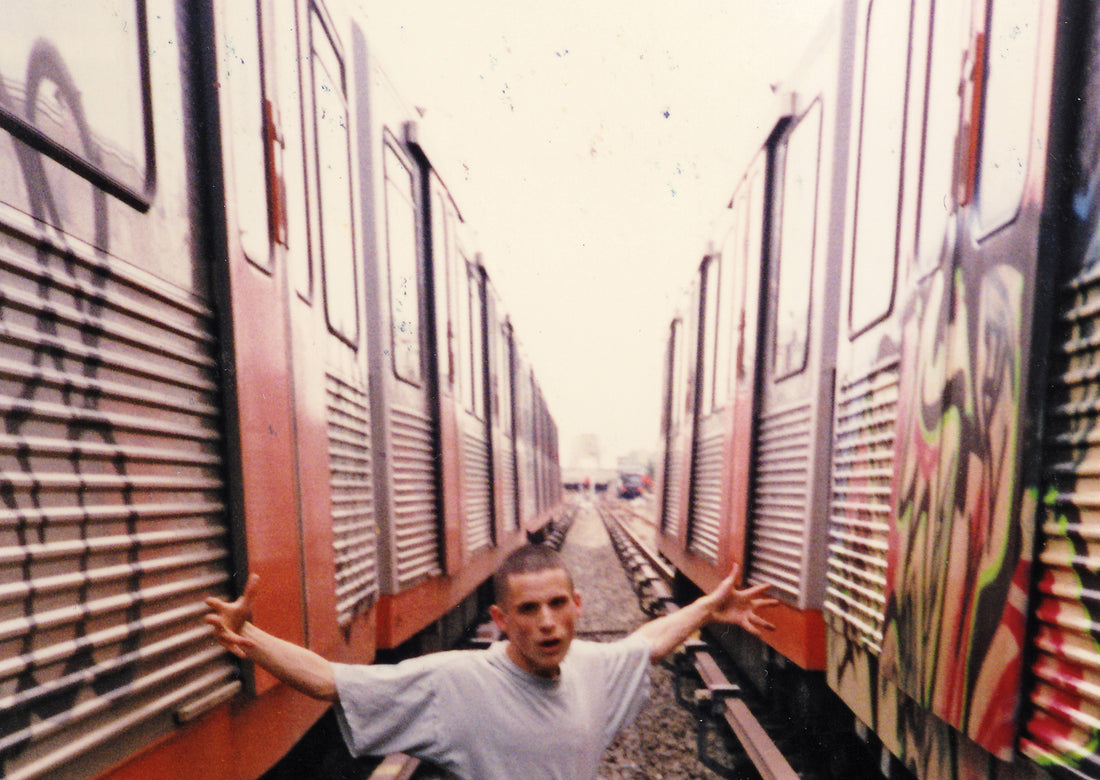For Catalogue of Unsolved Crimes, former graffiti legend MELLIE recalls dozens of ridiculous, reckless, totally illegal and sometimes hard to believe adventures in Europe’s train yards and metro tunnels. From his early days in hometown Utrecht at the dawn of the 1990s, MELLIE’s spray-painted name drove transportation companies to madness for the better part of a decade. The name of his MSN crew explained the modus operandi succinctly: Maniakken Stoppen Nooit (‘maniacs never stop’). Catalogue of Unsolved Crimes, containing many contemporary photographs of MELLIE’s pieces, is the first memoir of its kind and serves up vicarious thrills a mile a minute.
Did you have to wait to write this book until the statute of limitations for all of your various crimes had passed?
My friends and I always tried to keep our names and faces under the radar. I don’t think we could have published something like this twenty-five years ago. We talked to a lawyer, there is a limitation period which is now long overdue. They are not serious offences, it’s all very relative. Polluting the earth is a crime, lab testing on animals, migrant pushbacks on sea are crimes. We’re talking about layers of paint that have been applied to a surface without permission. I can imagine that some of my stories are pretty intense to some people though, because we went to great lengths to accomplish our missions. It was a cat-and-mouse game with the police, which was another thing that made it all so appealing.But why and how?
There’s a lot of conservation going on in graffiti, street art and hip-hop in general and I think we have something of interest to add. Fortunately, there is a large community of people who collect photos of graffiti. So I was able to find an awful lot of material that I didn’t have myself. Some kept pictures in shoeboxes in their attic that had not been touched for years. The pictures we took ourselves often turned out to be fucked up. Sometimes you couldn’t make a photo, but some guy in another part of the country would catch it later without you even knowing about it. Photographs have always been important, because a piece could be cleaned up within 24 hours. I spent three years trying to pull together all the images for the book before I started writing it, and asking other people to write something. They have helped me with their recollections. It’s crazy to be thinking about all this again more or less thirty years later. On the one hand, it’s all very cool. On the other hand, I sometimes thought to myself, my god, what the hell was I doing? Graffiti is very much something you don’t do alone.

It’s not strange for a teenager to be fascinated by something like graffiti art. The mysterious pseudonyms, secret crews and clandestine nature have an obvious appeal. But you took it several steps further than most people. We can safely call it a years-long obsession.
Yes, I remember most of my classmates in school were into rave music and football. I never gave a fuck about having a social life outside of graffiti. When there was an important game on TV, REAZE and I would hit the yards, because you knew that security was watching it too. It was all about getting up 24/7. We achieved a certain status, you could say, and it’s one I can still trade on.
Why did you take it so far?
In the late 1980s, when I was a teenager, the train bombing movement just exploded. By the time the Amsterdam public transportation company stopped buffing the subways, many first generation graffiti heroes had stopped, or were slowing down. There was a gap for me to fill. Painting trains was easy; we didn’t have enough paint and time to do more. I felt like I should take advantage and go the whole hog. One action wasn’t enough. It just went on and on. You were always plotting the next action. We lived outside of normal society. I don't think I sought that out consciously, but of course it has a certain appeal. I wouldn't be so quick to do some stuff now. But at the time, it was... just logical. It was a necessity. And of course I was also being young and naive. I didn’t care about getting a job or going to school.
You write a few times in somewhat veiled terms that your home situation was not ideal. Can we say that you found a different kind of family and sense of belonging in the graffiti community?
Absolutely. That’s the street life. Even with older writers taking care of you. At one point I started doing that myself, taking someone else under my wings. Everybody had this ‘one for all and all for one’ mentality, you really did things together.

Your Interrail trips are undeniably among the book’s highlights.
You enter a strange world and it turns out to be a kind of parallel society. Every country had its own scene. There were so many different styles, stories and heroes. Nowadays, you can find everything on the internet. Everyone has the same style. They use the same spray cans. It’s all organised in the same way. Which is cool. But back then, you didn’t know where you were going and how you were going to do it. But there was always a couch you could crash on, light up a joint and go out painting later that night.
You weren’t scared. Have you been lucky to come out the other end as well as you have?
Of course I was scared in certain situations, who wouldn’t be? But I think you’re right, and there are stories of people for whom things didn’t go so well. I think I have always had an angel on my back. What it was, I don’t know. Maybe just my intuition? Or plain luck? Probably a combination of those.
One of the final adventures in the book takes place in 1997, when you visit your Finnish graffiti friend EGS in London, where he is attending art college. Why does the story end there? Did you step out of the graffiti life around this time?
There were many very talented graffiti artists who made incredibly beautiful things and got a lot of recognition for it. That was not what I was doing though. At one point I had achieved something, a reputation.... and I didn't know what to do with it. When I went to college myself, I met different people. The need just wasn’t there anymore. I no longer felt the motivation to go out and paint. I could have continued for years, but what would that have done to me as a person?
You saw EGS going to art school. Was that an eye-opener for you, in the sense of: maybe I can do something else with this thing?
Many people from the graffiti world have gone to art school or ended up in the creative sector in another way. I am a big fan of EGS’s work. Graffiti became a part of his visual language, but it’s just a part of it. It’s more of a vehicle. Another one is PETRO. I always liked his graff and I understand where he’s coming from as a writer. He also knows how to twist that energy. His Ralph Lauren interventions and installations are insane. But the work I make now has nothing to do with graffiti at all. I always very consciously kept those things apart. I only very gradually started telling the people around me about my past. And they still don't fully understand the half of it.
Is this book a coming out for you, in some sense?
I think so. The stories were always in my head, of course. In a way it’s also a relief.

What do you hope readers take away from it?
A sense of the time it describes. The places we used to go to no longer exist. All those train models no longer exist. I just hope they continue to live on in this way. The amount of work we put in is worth mentioning in the line of history. I keep seeing pieces whenever I travel by train. It’s impressive and I would like to take some credit for pushing the game a bit further, for passing the torch. The maniac has stopped, but graffiti is still very much alive.

